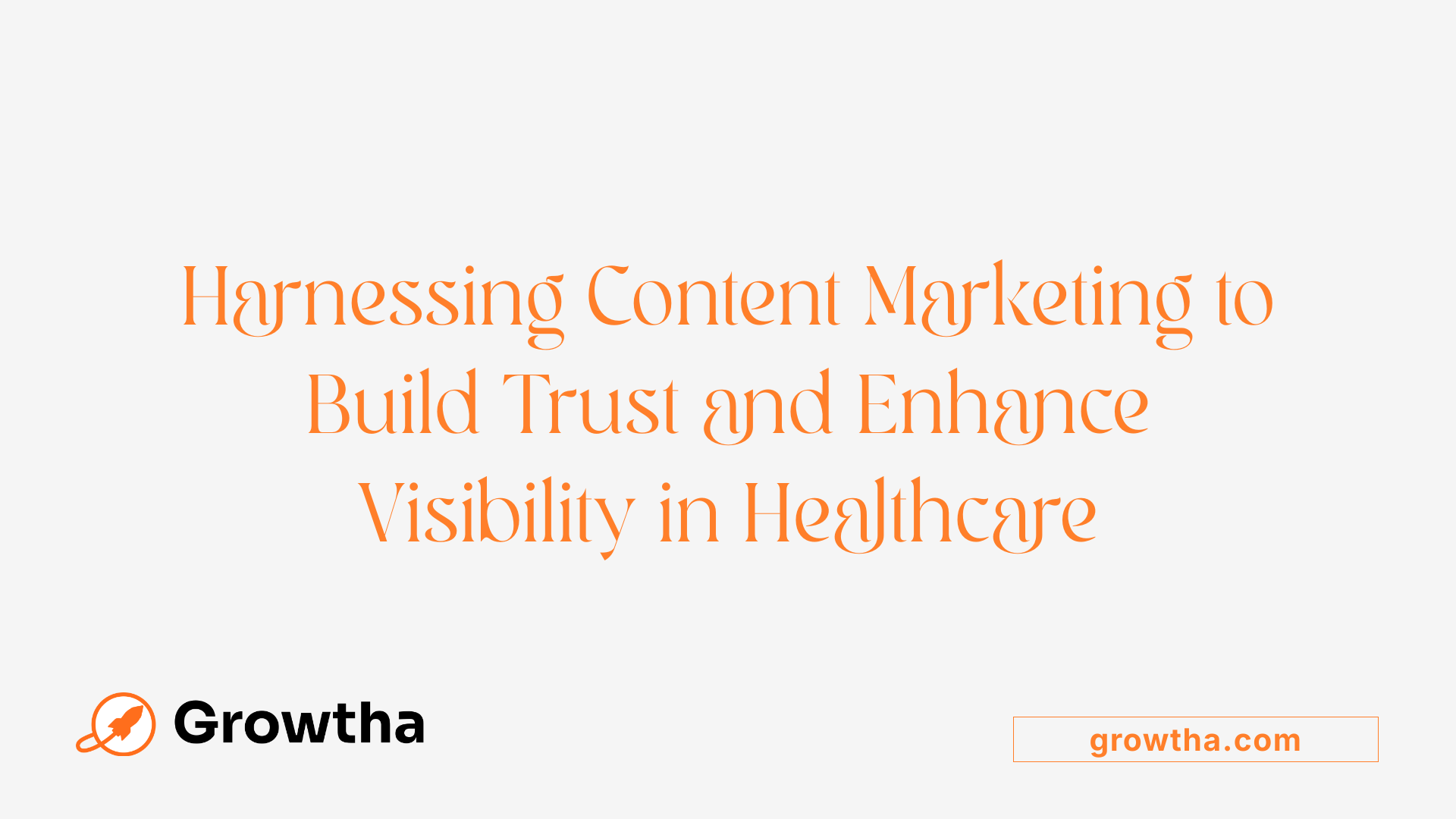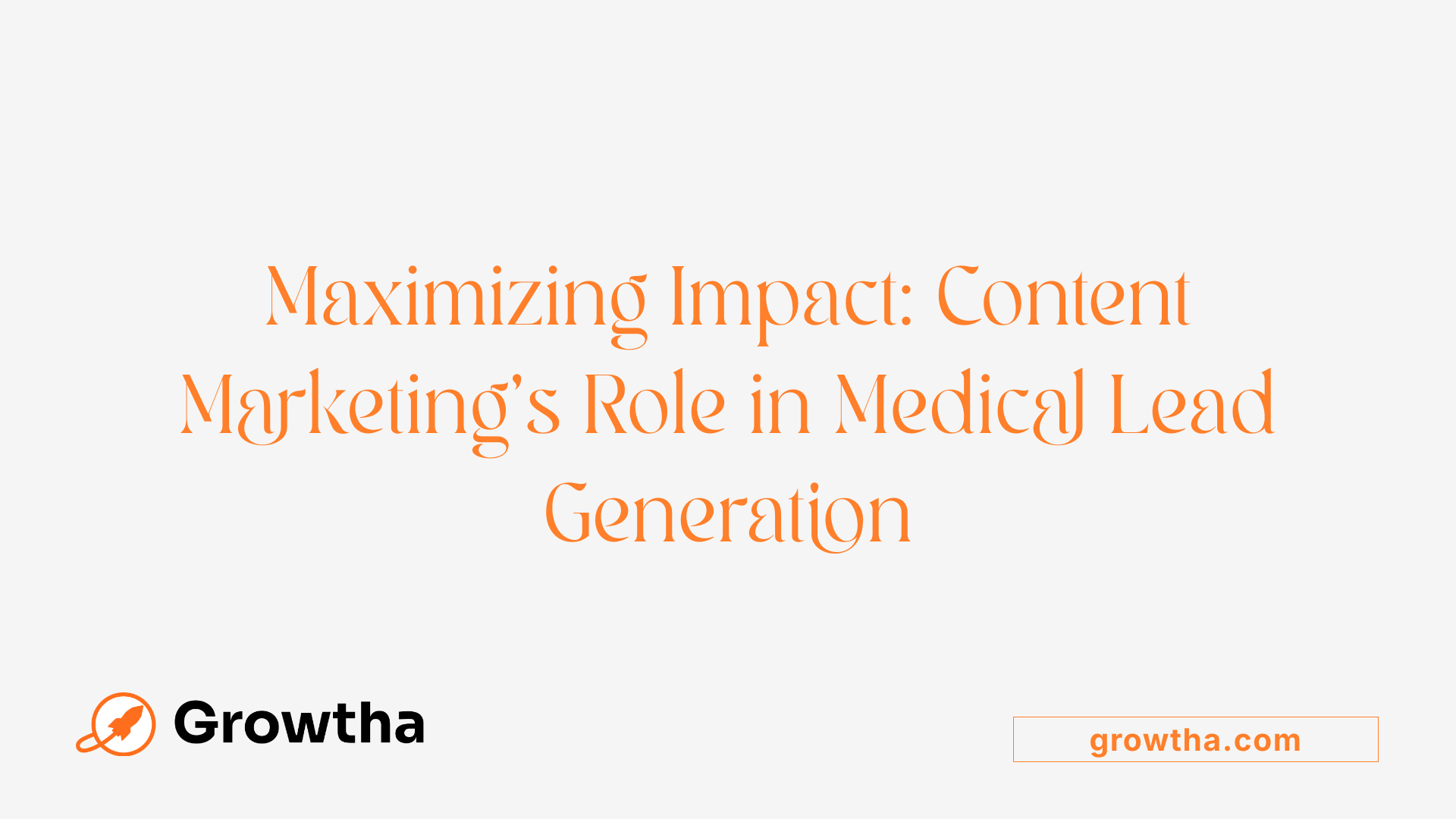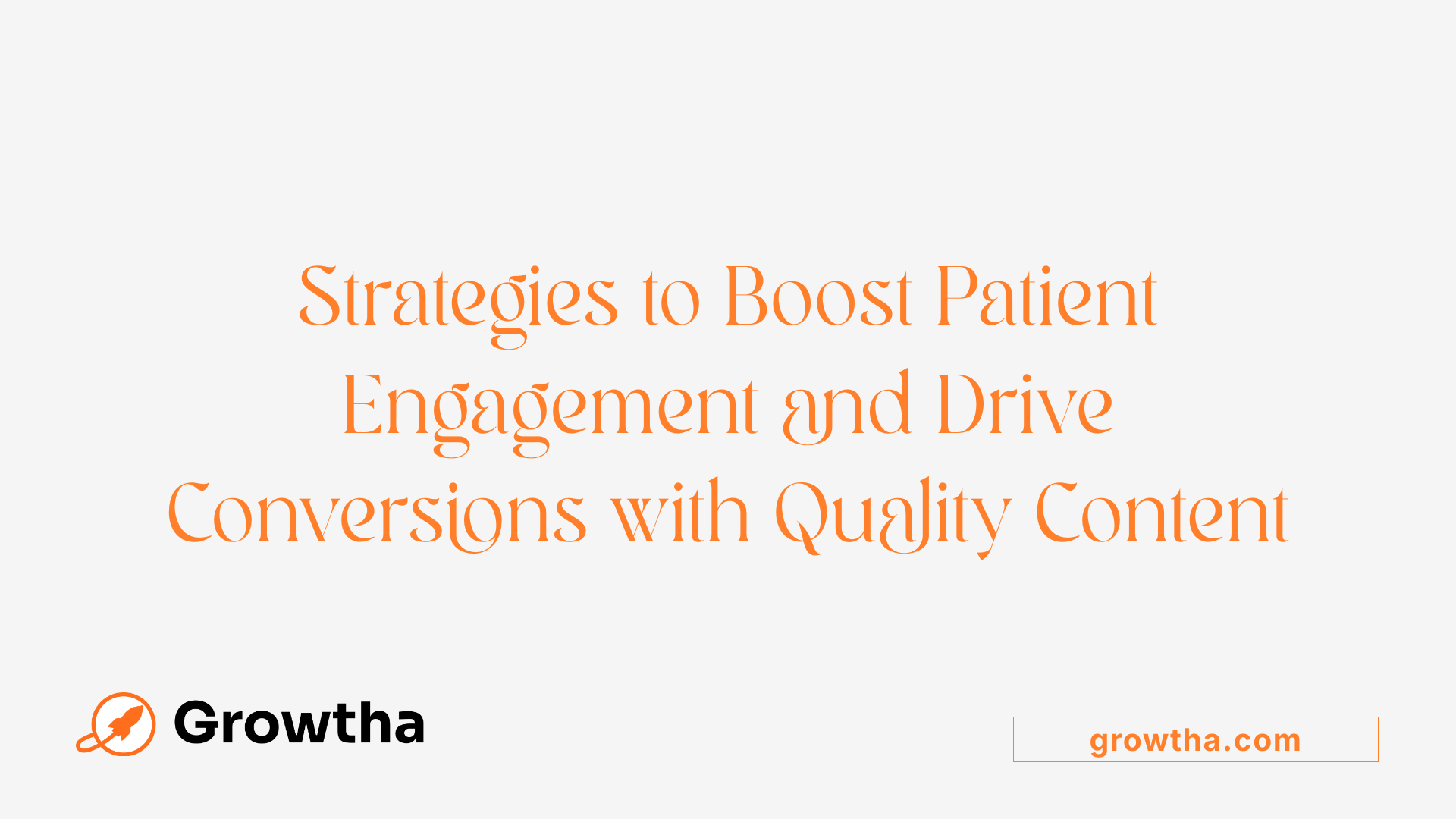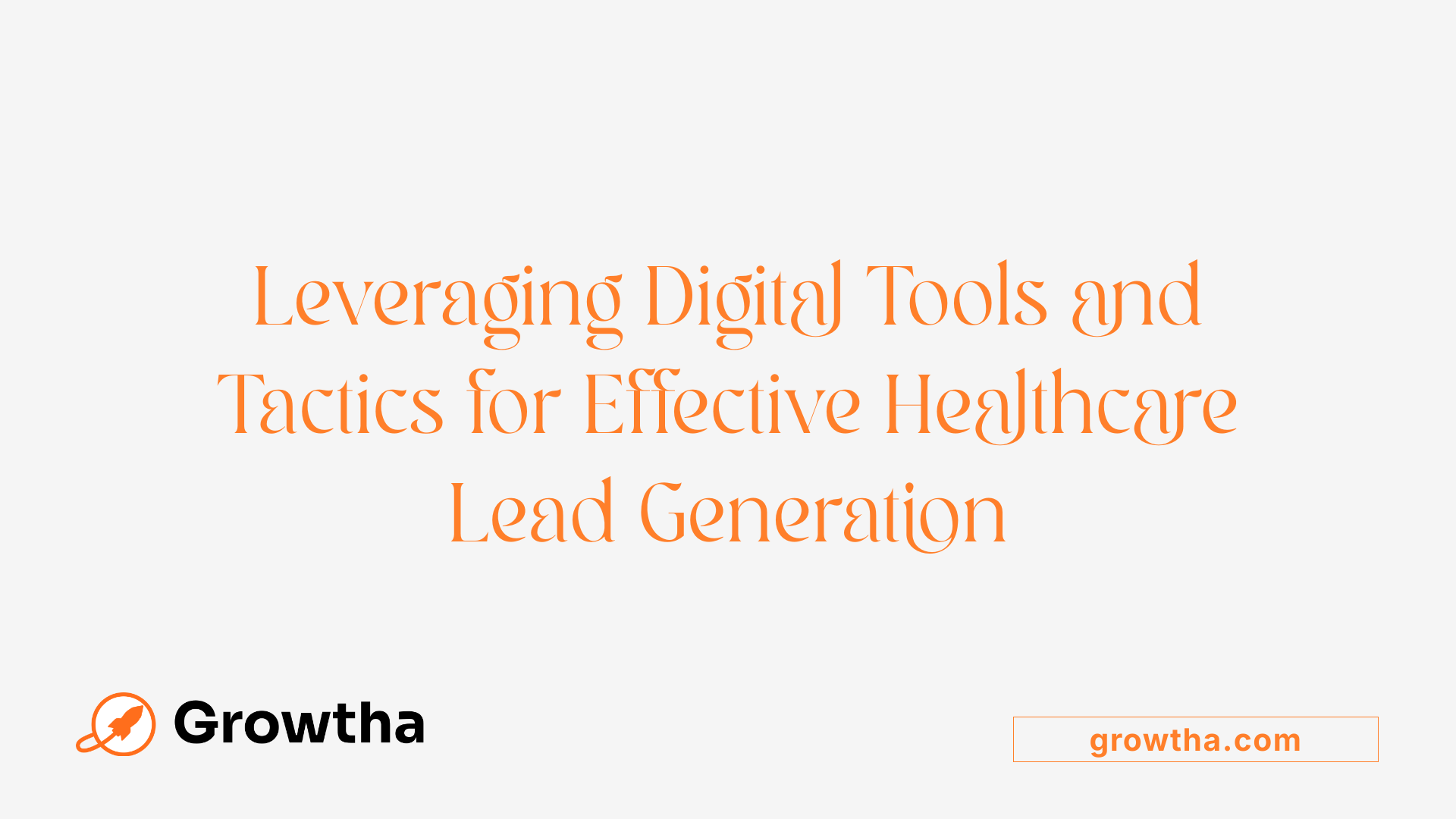The Role of Content Marketing in Medical Lead Generation
Harnessing Content for Healthcare Growth and Patient Engagement


The Role of Content Marketing in Medical Lead Generation
Understanding the Power of Content Marketing in Healthcare
Content marketing plays an essential role in the healthcare industry by helping providers attract, engage, and retain patients through valuable, relevant, and trustworthy information dissemination. It leverages multiple channels such as articles, videos, social media, and email campaigns to establish credibility and bolster online visibility. When effectively executed, healthcare content marketing not only educates patients but also positions healthcare providers as industry leaders, supporting continuous growth and long-term relationships.
Defining Content Marketing's Role in Healthcare
 Content marketing is an essential tool for healthcare providers aiming to connect with their audiences more effectively. Its primary purpose is to attract and engage patients by providing useful, relevant information that educates and empowers them about health issues and services.
Content marketing is an essential tool for healthcare providers aiming to connect with their audiences more effectively. Its primary purpose is to attract and engage patients by providing useful, relevant information that educates and empowers them about health issues and services.
Through various formats such as blogs, videos, infographics, and social media posts, healthcare organizations can build trust and credibility. Sharing patient success stories, expert insights, and evidence-based advice helps foster strong relationships and reassures patients about the quality of care they can expect.
In addition, content marketing significantly boosts online visibility. By optimizing content for search engines—through targeted keywords and local SEO tactics—practices become easier to find by prospective patients actively searching for healthcare services.
Positioning as thought leaders is another vital aspect. When healthcare providers share credible, comprehensive, and authoritative content, they establish themselves as trusted sources of health information, which further attracts new patients and reinforces long-term loyalty.
Beyond patient attraction and trust-building, content marketing supports practice growth and patient education. Well-crafted content informs patients about medical conditions, treatment options, and preventive measures, leading to better health outcomes and more informed decision-making.
In summary, content marketing in healthcare plays a multifaceted role. It not only enhances visibility and reputation but also bridges the communication gap between patients and providers, ultimately supporting sustainable practice development and improved community health.
The Strategic Importance of Content Marketing in Medical Lead Generation

What role does content marketing play in medical lead generation?
Content marketing serves as a foundational element in attracting and converting potential patients in the healthcare sector. By producing useful, relevant, and educational content—such as blog posts, videos, case studies, and white papers—healthcare providers can effectively address the specific needs and concerns of their target audience.
This approach not only builds trust and credibility but also positions the organization as an authority in its field. Quality content helps guide prospects through the patient journey, from initial awareness to consideration and decision-making.
Furthermore, content marketing supports the deployment of strategic tools like landing pages and lead magnets—free resources such as downloadable guides or webinars—that encourage visitors to share their contact information.
When these tools are integrated with channels like social media, email campaigns, and the organization’s website, they enable personalized and targeted engagement.
Automated systems can capture and nurture leads by providing timely follow-up communications, making the process efficient and scalable.
In summary, content marketing amplifies visibility and establishes trust, making it a crucial strategy for healthcare organizations aiming to generate qualified leads, increase patient intake, and optimize marketing resources effectively. This method ultimately leads to higher conversion rates and sustainable growth in the competitive healthcare landscape.
Clarifying the Purpose and Principles of Healthcare Content Marketing
What is the purpose of content marketing in healthcare?
Content marketing in healthcare aims primarily to educate and inform patients and consumers. It involves creating and sharing helpful, relevant, and engaging materials such as articles, videos, podcasts, infographics, and guides that directly address common health questions, concerns, and needs.
By providing high-quality health information, healthcare providers can establish themselves as trustworthy sources of knowledge. This not only aids patients in making informed decisions but also builds credibility and trust in the provider’s brand.
Effective content marketing strategies ensure that the information shared is accurate, sourced from reputable institutions like The New York Times and Scientific American, and compliant with legal and ethical standards.
A strategic approach includes using credible sources, consistent posting, and deploying content across multiple channels (omnichannel approach) such as social media, websites, email newsletters, and online communities. These tactics increase visibility, foster engagement, and position the healthcare provider as a thought leader.
Beyond attracting new patients, content marketing fosters loyalty among existing patients. By delivering ongoing, valuable health insights, healthcare organizations enhance patient retention and encourage long-term relationships.
Partnering with content licensing organizations empowers healthcare entities to access and distribute unbiased, up-to-date information. This collaboration helps maintain content quality, meet compliance requirements, and address diverse patient education needs.
Overall, healthcare content marketing is a vital component for building trust, improving patient understanding, and supporting sustainable growth through informed patient interactions.
Guiding Principles for Effective Content Marketing Strategies
What are the fundamental principles guiding content marketing strategies?
Effective content marketing in healthcare builds on several core principles that ensure messages are relevant, engaging, and compliant with regulations. At the heart of these principles is a thorough understanding of the target audience's needs, preferences, and behaviors. This understanding enables healthcare organizations to develop content that educates, empowers, and resonates with potential patients and professional partners.
A strategic approach involves categorizing content into four main types: Attraction, Authority, Affinity, and Action. Each category plays a vital role in guiding prospective patients along their journey. Attraction content aims to draw visitors through SEO-optimized blogs, videos, and social media posts. Authority content establishes expertise via whitepapers, comprehensive guides, and collaborations with healthcare professionals. Building affinity involves creating content that fosters community and trust, such as patient stories and testimonials. Finally, action-oriented content encourages conversions through targeted calls to action—like scheduling appointments or subscribing to newsletters.
Implementing the 5 P’s of social media marketing—Plan, Produce, Publish, Promote, and Prove—is essential for executing successful campaigns. Planning involves mapping out content themes aligned with organizational goals. Producing high-quality, accurate content ensures professionalism and credibility. Publishing strategies focus on selecting platforms where target audiences are active, while promotion amplifies reach through paid advertisements and sharing. Proving success involves measuring engagement, conversions, and ROI using analytics tools, which guides continuous improvement.
SEO optimization is a vital component within attraction content. Techniques such as keyword targeting, website structure enhancement, and local SEO improve organic traffic and online visibility. In addition, aligning content efforts with overarching organizational goals—including brand awareness, patient acquisition, and trust-building—ensures all activities contribute to business growth.
A unified approach that integrates audience insights, categorization of content, strategic use of social media principles, SEO practices, and measurable objectives fosters a comprehensive strategy. This approach not only attracts and retains healthcare audiences but also builds long-term loyalty, substantiates professional credibility, and ultimately supports the organization’s mission of providing quality care.
Effective Formats and Types of Healthcare Content
What types of content and formats are effective for healthcare marketing?
In healthcare marketing, employing a diverse set of content formats is essential to reach different audience segments effectively. The most impactful content types include informative blog posts, engaging videos, visually appealing infographics, comprehensive white papers, educational webinars, and heartfelt patient testimonials.
Blogs serve as a foundation for sharing expert advice, answering common questions, and improving SEO rankings. Videos, whether explaining complex medical procedures or featuring patient stories, humanize the healthcare brand and are highly shareable on social media platforms. Infographics distill intricate health data into easy-to-understand visuals, enhancing viewer comprehension and engagement.
White papers and e-books provide in-depth insights into medical topics, establishing credibility and authority for healthcare providers. Webinars and live Q&A sessions facilitate real-time interaction, allowing audiences to ask questions directly and deepen their understanding. Patient testimonials build trust by sharing genuine success stories, influencing potential patients’ decision-making.
Using a strategic combination of these formats aligns with patient preferences and supports various stages of the patient journey—from awareness and consideration to decision and loyalty. Multimedia elements like videos and infographics help simplify health information and humanize healthcare providers, fostering trust.
To maximize reach, healthcare content should be disseminated across multiple channels, including websites, social media, email campaigns, and digital advertising. Storytelling and thought leadership in these formats reinforce the provider’s expertise while maintaining compliance with regulations and ethical standards.
In summary, a well-rounded content strategy that leverages varied formats—coupled with credible and accessible information—plays a pivotal role in effective healthcare marketing, driving engagement, trust, and ultimately, patient conversion.
Enhancing Patient Attraction and Conversion via Content

How does content marketing impact patient attraction and conversion?
Content marketing plays a critical role in attracting and converting patients in the healthcare industry. By developing and sharing high-quality, relevant health information, healthcare providers can directly address patients’ questions and concerns. This approach helps establish trust and credibility, which are essential for encouraging patients to choose a particular provider.
In today’s digital age, most patients begin their health research online. They look for trusted sources that offer clear, accurate, and engaging content. Articles, videos, infographics, and social media posts serve as valuable touchpoints that introduce new audiences to healthcare organizations and guide them through their decision-making process.
Implementing well-planned SEO strategies ensures that this content ranks higher in search engine results, making it easier for potential patients to find and access the provider’s information. Multimedia elements like videos and interactive content capture attention and enhance understanding, increasing the likelihood of appointment bookings.
Personalized communication is also key. Tailoring content to specific patient personas—based on age, health concerns, or location—creates a more engaging experience. This approach not only attracts new patients but also fosters loyalty among existing ones.
Furthermore, consistent and targeted content builds the organization’s reputation as a credible authority in the health sector. Over time, this trust translates into higher conversion rates, as patients feel more confident in their choice and are more likely to schedule visits or consultations. In summary, a strategic content marketing effort strengthens the overall patient journey from initial interest to long-term engagement, ultimately boosting new patient acquisition and reinforcing growth.
Digital Tools and Tactics Supporting Lead Generation

What digital marketing tools and tactics support medical lead generation?
Efficient lead generation in healthcare relies on a blend of innovative tools and strategic tactics. Digital marketing encompasses several components designed to attract, engage, and convert potential patients and healthcare professionals.
One of the primary elements is Search Engine Optimization (SEO). SEO enhances a healthcare organization’s online visibility by optimizing website content and structure for search engines. This helps attract high-quality organic traffic from individuals actively seeking medical services. Well-implemented SEO strategies include keyword research tailored to healthcare topics, local SEO practices for geographic targeting, and technical optimizations like site speed and mobile-friendliness.
Content marketing further bolsters lead generation by providing valuable and educational material. Blogs, videos, podcasts, and webinars are used to answer common patient questions, educate audiences on health conditions, and share success stories. Such content builds trust and positions providers as credible experts, encouraging visitors to engage and convert.
Paid advertising, including Pay-Per-Click (PPC) campaigns and targeted social media ads, offers immediate exposure to highly specific audiences. These campaigns can focus on geographic regions, age groups, or particular health concerns, leading to high-intent inquiries and appointments.
Social media platforms—Facebook, LinkedIn, Instagram, and Twitter—serve as vital touchpoints for engaging with potential patients. Both organic posts and paid ads help reach diverse demographics, foster community, and direct users toward conversions.
Email campaigns nurture ongoing relationships by sending personalized messages, newsletters, and targeted offers. Automation tools help segment audiences and deliver timely, relevant content, improving the chances of lead conversion.
In addition to these tactics, healthcare providers are increasingly leveraging advanced tools like chatbots, Customer Relationship Management (CRM) systems, and reputation management software. Chatbots provide 24/7 response capabilities, capturing leads instantly and answering common queries without delay. CRMs help track interactions, maintain comprehensive contact profiles, and automate follow-up communication. Reputation management platforms monitor online reviews and feedback, enhancing trust and credibility.
Emerging technologies, such as virtual consultations and AI-driven tools, further support lead generation by offering convenience and tailored patient experiences. Virtual visits attract busy or remote patients, expanding the reach of healthcare providers. AI-powered analytics and personalization apps enable precise targeting, improving campaign effectiveness.
In sum, these digital tools and tactics work synergistically to create a robust ecosystem for generating and nurturing healthcare leads effectively. Controlling these elements allows organizations to maximize their online presence, foster meaningful patient engagement, and ultimately, increase conversions.
Best Practices for Healthcare Content Creation and Organization
What are best practices for healthcare content creation and organization?
Creating effective healthcare content requires a thorough understanding of the target audience. It is essential to consider factors such as patient demographics, health literacy levels, and informational needs. Content must be clear, accurate, and engaging to facilitate trust and comprehension.
Aligning content with organizational goals ensures that messaging supports broader marketing and healthcare objectives. To manage content effectively, employing strategic frameworks like content calendars is highly recommended. These tools help plan, schedule, and coordinate content publication across channels, ensuring consistency and timely delivery.
Content calendars also allow organizations to support different stages of the patient journey—from awareness to decision-making—and to leverage seasonal or awareness campaigns for increased relevance.
Compliance with legal and ethical standards is critical in healthcare. Content must respect privacy regulations such as HIPAA and GDPR, which safeguard patient data. Respecting patient privacy, citing credible sources, and avoiding misleading claims are fundamental to building and maintaining trust.
Incorporating SEO techniques enhances content visibility. Using relevant healthcare keywords, optimizing headlines, and improving website structure make content more accessible through search engines. Additionally, diversifying content formats—including blogs, videos, podcasts, webinars, and infographics—appeals to varied learning preferences.
Repurposing existing high-quality content maximizes reach and efficiency. For example, transforming a webinar into a series of blog posts or creating short videos from longer tutorials can expand audience engagement.
Monitoring key metrics such as engagement, click-through rates, and conversions allows organizations to measure success and refine their strategies effectively. Following industry guidelines and best practices for social media and digital communication further ensures that content remains professional and trustworthy.
Overall, adopting these best practices for healthcare content creation and organization will help healthcare providers educate their audiences, foster trust, and achieve their marketing and patient engagement goals.
Leveraging AI and Innovations in Healthcare Content Marketing

How are AI and digital innovations integrated into healthcare content marketing?
Artificial intelligence (AI) and digital technologies are transforming healthcare content marketing by making efforts more precise, efficient, and personalized. These innovations analyze vast amounts of patient data and online behavior to deliver hyper-personalized messaging across websites, social media, and email campaigns. This targeted approach helps healthcare providers reach the right audience with relevant information, ultimately building trust and engagement.
AI also automates many aspects of content creation and distribution. For instance, AI-powered tools can generate compliant, high-quality content such as blog posts, updates, or social media posts based on healthcare trends and patient needs. These tools can suggest optimal posting times, monitor campaign performance in real time, and adjust strategies accordingly, ensuring marketing efforts are always aligned with audience interests.
Beyond content automation, AI enhances the technical side of digital marketing. It improves search engine optimization (SEO), makes social media marketing more effective, and tailors email marketing campaigns to individual patient preferences. AI helps identify when a patient is most receptive to specific messages, thereby increasing the chances of timely engagement.
AI-driven chatbots, symptom checkers, and other website features have become vital tools for healthcare organizations. Chatbots provide instant answers to common patient questions, guide users through appointment scheduling, or deliver health tips personalized to the user’s profile. Symptom checkers help patients determine the severity of their health concerns, reducing unnecessary visits and relieving healthcare staff.
These technologies also streamline marketing operations, reducing workload, cutting costs, and improving outreach. They generate valuable insights from data, enabling clinics and hospitals to anticipate patient needs better and refine their marketing tactics continuously. Overall, integrating AI and digital innovations not only enhances patient experience but also makes healthcare marketing more responsive, compliant, and impactful.
Driving Growth and Trust through Content Excellence
Effective content marketing is a cornerstone of successful healthcare practice growth and patient engagement. By adhering to strategic principles, leveraging diverse formats, embracing digital tools, and maintaining compliance with industry standards, healthcare organizations can enhance their online presence, attract qualified leads, and foster long-term patient relationships. The convergence of innovative technologies like AI further amplifies these efforts, enabling personalized, efficient, and impactful communication. Continued investment in quality content creation and strategic distribution will ensure healthcare providers remain competitive, trustworthy, and capable of supporting patient needs in a rapidly evolving digital landscape.
References
- (PDF) The role of content marketing in the promotion of medical ...
- Medtech Content Marketing: 2025 Guide - First Page Sage
- Healthcare Content Marketing: All You Need to Know - Podium
- A Beginner's Guide to Medical & Healthcare Lead Generation
- We Present 6 Best Healthcare Lead Generation Strategies in 2024
- Best Healthcare Content Marketing Strategies for Engagement
- The Ultimate Guide to Medical Lead Generation Strategies for Success
- Mastering Lead Generation for Healthcare Industry - Alore
- The Crucial Role of Marketing in Supporting Healthcare Sales Teams
- The Essential Role of Content Marketing for Health, Wellness, and ...







